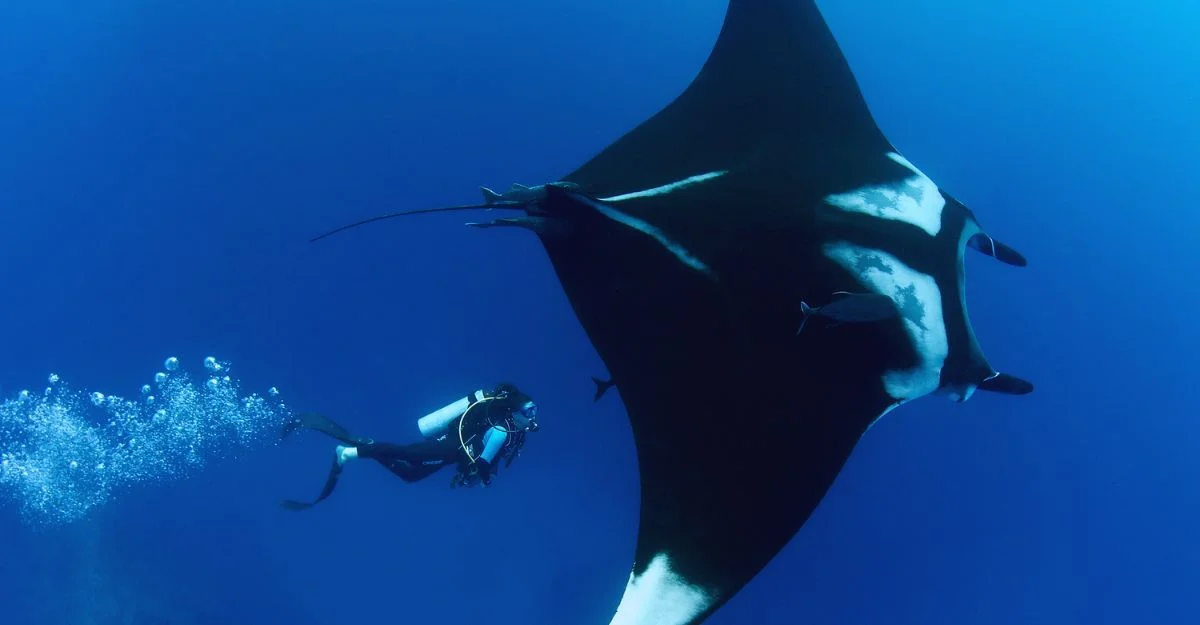Manta alfredi and Manta birostris have recently been reclassified from the devil rays and represent sister species in a new family of Mobulidae. Manta rays are easily considered charismatic megafauna; they are large, slow-growing, and late to mature; they are typically found in shallow, warm, heavily used tropical and subtropical habitats; and they are often exposed to imminent molecular threats due to human fishing. Recent reports have emphasized the value of manta rays for both eco- and endothermic tourists around the world, emphasizing their critical role in local economies. Additionally, they have been related to ecological and ecosystem services, such as support for reef fish and coral life, and of course, biological capital provided by comparing diving experiences and subsidizing local economies.
Over the past ten years, the popularity of the pet trade has somewhat put mantas on the global stage. The rapid development and acceptance of manta rays by scientists and divers alike increased the urgency of promoting the conservation of these sensational animals. The tall bow of manta rays enables a large amount of nutrients to flow through the filter in front of the mouth while swimming. Their exceptional hearing system, extremely detailed brain, and complex physiology are difficult to transport and breed, but the ease of observing and maintaining them in a protected environment in an educational capacity can surely capture even those who do not want to involve themselves in diving.
Manta rays, often referred to as “gentle giants of the ocean,” are among the most fascinating and majestic marine creatures. Known for their enormous size, graceful movements, and unique appearance, these creatures have captured the imagination of ocean lovers and researchers alike. This article dives deep into the world of manta rays, exploring their biology, behavior, habitat, and the challenges they face in today’s changing oceans.
Taxonomy and Species
Manta rays belong to the family Mobulidae and are closely related to other rays and sharks. There are two recognized species of manta rays:
- Reef manta ray (Mobula alfredi)
This species is generally smaller and is commonly found in coastal waters, particularly around coral reefs. - Giant manta ray (Mobula birostris)
As the name suggests, this is the larger of the two species, often found in the open ocean and capable of impressive migrations.
Manta rays are part of the Mobula genus, and their close relatives, the devil rays, share similar physical characteristics.
Physical Characteristics
Size and Appearance
Manta rays are known for their impressive size, with wingspans ranging from 4 to 7 meters (13 to 23 feet) for reef manta rays and up to 9 meters (30 feet) for giant manta rays. Despite their large size, they are remarkably agile, gliding effortlessly through the water.
Their bodies are flattened and disc-shaped, with triangular pectoral fins that resemble wings. A distinguishing feature of manta rays is their cephalic fins—two protrusions on either side of their mouths that help funnel plankton-rich water during feeding.
Coloration
Manta rays exhibit countershading, with a dark dorsal side and a lighter ventral side. This coloration provides camouflage, protecting them from predators like sharks.
Habitat and Distribution
Manta rays are found in tropical, subtropical, and temperate waters around the world. They inhabit a variety of marine environments, including:
- Coastal reefs
- Open ocean
- Seamounts and atolls
The reef manta ray is typically observed near shorelines and coral reefs, while the giant manta ray prefers deeper waters and is known for its long migratory routes.
Diet and Feeding Behavior
Filter Feeders
Manta rays are filter feeders, relying on plankton and small fish as their primary food sources. Using their gaping mouths, they swim through plankton-rich waters, capturing food particles with specialized gill rakers.
Feeding Techniques
Manta rays employ various feeding strategies, including:
- Barrel rolling: Swimming in a circular motion to concentrate plankton.
- Chain feeding: Forming groups to maximize feeding efficiency.
Social Behavior and Intelligence
Manta rays are highly social and intelligent creatures. They are known to interact with one another and display behaviors that suggest advanced cognitive abilities.
Social Structure
- Manta rays are often seen in small groups, although solitary individuals are common.
- Cleaning stations—where smaller fish remove parasites from the manta ray’s skin—serve as social hubs.
Intelligence
- Manta rays have the largest brain-to-body ratio among fish, suggesting advanced problem-solving abilities and curiosity.
- Studies have shown that they can recognize their reflections, a trait associated with self-awareness.
Reproduction and Life Cycle
Manta rays are ovoviviparous, meaning they give birth to live young after the eggs hatch inside the mother’s body. The reproductive cycle includes:
- Mating dances: Males follow females in elaborate displays to compete for mating rights.
- Gestation: The gestation period lasts about 12-13 months, after which a single pup is born.
Newborn manta rays are independent from birth but remain vulnerable to predators.
Ecological Importance
Manta rays play a crucial role in marine ecosystems. By feeding on plankton, they help regulate populations and maintain a healthy balance in the food chain. Their movements also contribute to nutrient cycling, as they transport nutrients across vast oceanic distances.
Threats to Manta Rays
Manta rays are large fish found in the tropical oceans of the world. They are related to sharks and have skeletons made of cartilage, which is a soft rather than hard bone. Mantas eat tiny creatures such as plankton, which they filter from the seawater through special structures in their heads called gill rakers. You can easily see the gill slits on this manta’s head in close-up. Mantas have broad flaps that stick out at the sides of their mouths called cephalic lobes, which are typical of this group of fish. Manta rays flap their wing-like fins to swim through the water, which makes them look like they are flying. They are graceful swimmers and move easily and rapidly through the water. Mantas grow to be really big fish. The broad fins of the larger species can span up to twenty feet across. With the big fins and the long tails that stick out behind them, they can measure over thirty feet in length. That’s as long as some buses!
There are two species of manta rays. The members of these species look very similar to each other, but they have different distributions and their local names are also different. They are the giant oceanic manta ray and the reef manta ray. The reef manta is the smaller of the two species. They both prefer the warmer water of the world’s tropical and subtropical zones, and they both migrate to get food. When the climate of the teeming tropical seas of our planet changes and the rainy season ends, and food for manta rays becomes scarce, they start swimming to different areas of the oceans where their food is in season year-round. The place where they live is called their habitat. Many of the places where manta rays are commonly seen are called hot spots by divers, which isn’t surprising because mantas are top attractions for divers. In some cases, these places are voyagers, which means that manta rays often come there to make a journey between their regular habitats.
Physical Characteristics and Behavior
Manta rays are cartilaginous fish and the second largest species of ray in the world. The largest is the whale shark. Both species are filter feeders that consume plankton and small fish. The only species of manta rays that is relatively well understood by scientists is Manta birostris, the giant manta ray. The other large species is Manta alfredi, the reef manta ray. Scientists are not yet certain if the two manta species are full species or just different populations of the same species. Based on external features, it is possible to identify which species is which. Little information has been collected on the life history of either species. There is great concern that current direct and indirect threats to mantas could threaten the species’ very existence.
At maturity, giant mantas commonly exceed 430-500 cm in width. At the maximum reported size of 730 cm, manta rays reach weights well over 1,500 kg. While it is hard for scientists to gather data on these underwater behemoths, they have made some observations about mantas’ life history. Most individual mantas do not reproduce until they reach between four and eight years old. Mating occurs throughout the year in some areas; others have determined that it occurs in the spring months. The length of gestation and parturition patterns are not well determined. Manta rays typically give birth to a single pup but occasionally produce twins. The relatively new database has only five records of twin pregnancies in the giant manta. The eastern Pacific population is believed to mate and pup close to the coast. The female may have a pregnancy requiring twelve months or more. In aquaria, gestation has been thought to be 12-15 months long. Mantas are among the most intelligent of fish that have been studied. They exhibit social behaviors, appear playful, and recognize themselves in a mirror. Although mantas are known to jump out of the water, nobody knows why. Although predator avoidance was typically thought to be the reason, possible alternative explanations include communication or parasites. While the established Red List for manta rays exists, many areas of manta life history remain a mystery.
Threats and Conservation
Human Impacts
Manta rays face numerous threats, including:
- Overfishing: Manta rays are targeted for their gill plates, which are used in traditional medicine.
- Bycatch: Accidental capture in fishing nets poses a significant risk.
- Habitat loss: Coral reef degradation and coastal development threaten their habitats.
Conservation Efforts
- Protected areas: Marine sanctuaries and no-fishing zones provide safe havens for manta rays.
- CITES listing: Manta rays are listed under the Convention on International Trade in Endangered Species, restricting their trade.
- Awareness campaigns: Organizations like the Manta Trust work to educate the public and promote conservation.
Fascinating Facts
- Manta rays can leap out of the water, a behavior thought to be related to communication, mating, or parasite removal.
- Their name comes from the Spanish word “manta,” meaning “blanket,” referring to their large, flat bodies.
- Manta rays can live for more than 20 years in the wild.
How You Can Help
Protecting manta rays requires a collective effort. Here’s how you can contribute:
- Support eco-tourism initiatives that promote responsible manta ray interactions.
- Reduce plastic waste, as pollution severely impacts marine life.
- Advocate for policies that protect ocean biodiversity.
Conclusion
Manta rays are more than just breathtaking creatures—they are vital components of marine ecosystems and symbols of the ocean’s incredible biodiversity. By understanding their lives and addressing the threats they face, we can ensure these gentle giants continue to thrive in our oceans for generations to come.

